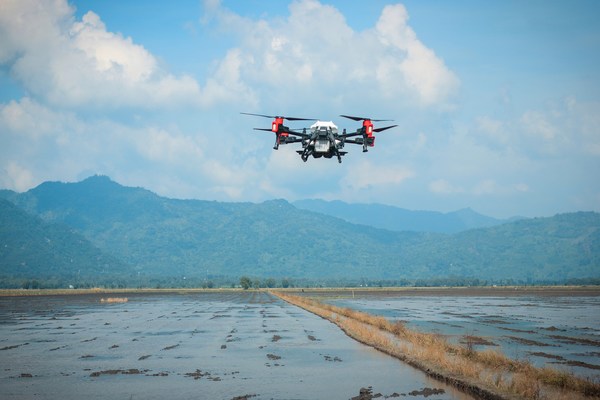CAO LANH, Vietnam, May 9, 2022 /PRNewswire/ — As the monsoon season starts with ample rainfalls, XAG is actively scaling up the use of its agricultural drones in Vietnam to make rice production more sustainable. Faced with the soaring prices of agricultural inputs, Vietnamese farmers can now employ drones from XAG to grow more rice using fewer resources. From direct seeding, pesticide spraying to fertilizer application, XAG’s agricultural drones have seen its increasing popularity among rural youth who are keen to earn a decent salary as drone pilot.
Vietnam is the world’s second largest exporter of rice, which is also the staple food consumed by 90% of the total population and the main source of income for millions of small-scale farmers. More than 50% of the country’s rice is cultivated in the Mekong Delta region, known as the ‘rice bowl’ of Vietnam that produces three crops per year. However, the surge in fertilizer and pesticide prices, as a result of global supply chain disruption, has urged Vietnamese farmers to cut back crop nutrients and chemical essential to boosting rice yields.
Ease the rising cost strain on farmers
Across the rice fields of Mekong Delta, XAG has been working with local service teams to help rice farmers use resources more effectively and fight the rising costs. Drones designed for agricultural use can reduce seeds, pesticides, and fertilizers without affecting crop yields through precise, effortless operation. According to XAG’s local distributor DigiDrone, compared with traditional farming, agricultural drone can spray crops 4 times faster than manual labor while improving yield by 14%.
The Mekong Delta becomes the major battlefield to adopt new technology and shift away from intensive rice farming. In Dong Thap province, XAG P40 agricultural drone was used to spread lime on a 40-day paddy field to treat bacterial disease and provide calcium nutrients for rice plants. In addition to pesticide application, broadcasting of granule fertilizer and crop nutrient is another primary scenario of drones.
During the operation, the young pilot controlled the drone with a smartphone and preset parameters including flight speed, height, lime volume and spreading width to fulfill automation. As the XAG drone carried a 25-liter container and the spreading system RevoCast, the lime powder was spread evenly and accurately on the 1.5-hectare rice paddy. The strong wind force of the drone helped lime in contact with the rice plant from top to bottom, saving 30% lime powder and enabling better absorption by the crops.
Maintain good yield with less effort
An agricultural demonstration was also held in Dong Thap to compare the results of manual sowing and direct seeding by drone. Farmers used to work all day bending over, ankle deep in the mud to transplant seedlings, but now rice seeds can be sown directly into the flooded fields, which requires less labor and saves time.
Flying autonomously on the pre-programmed route, the XAG P40 agricultural drone could distribute rice seeds uniformly into the designated area. The performance of drone seeding was as smooth as manual operation to help farmers achieve optimal plant density. It is reported that one hectare of rice crops was sown in two hours with 160 kilograms of seeds that had nearly 100% germination. As the winter-spring season came to an end in April, this rice paddy had reaped an actual harvest of 8 metric tons per hectare while saving seeds by 35%.
Nguyen is a rice farmer in his 40s who lives in the Mekong Delta region and grows a rice field of 4 hectares. He uses XAG’s agricultural drone for the first time this year to sow seeds, spray pesticides and spread fertilizer, becoming an early adopter of drone technology in Vietnam’s farming industry. Over the past years, Nguyen had to carry a heavy backpack spreader or an old-fashioned hand sprayer, which was not only inefficient but also increased the risk of exposure to chemical.
"Traditionally I could only spray an area of 5 hectares in a day, but now with the help of XAG’s farming drone, 30 hectares of rice fields can be precisely treated without lots of effort," said by Nguyen. When applying fertilizer to boost rice growth, the drone can also help Nguyen halve the amount of fertilizer and spread at an efficiency of 10 hectares in a single day. The same area of fertilizing operation would take farm workers several days to complete manually.
As an increasing number of farmers realize the benefits of drone, this new technology will soon scale up in Vietnam to boost the resilience of smallholders against climate change and market fluctuation. To serve the growing crop protection demand on a larger scale, XAG will be ready to release a new model of agricultural drone for the Vietnamese market that feature larger payload capacity.
For more information about how XAG leverages digital technology to transform agriculture, please visit https://www.xa.com/en/news




